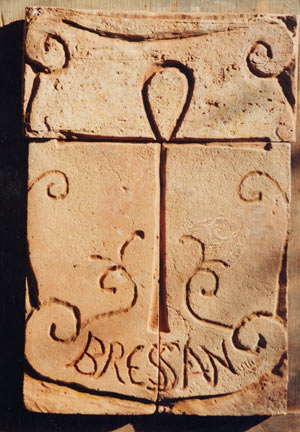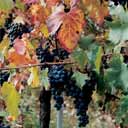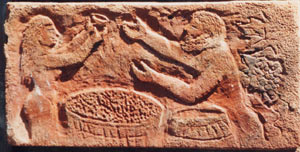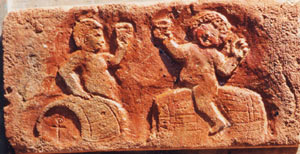|
|
|
|
|
|
|
|
|
|
|
|
|
 |
|
 |
|
 |
|
|
And in the night, pallid traces of cart tracks appear, leading towards the past, running along the ancient Roman roads that lead to the easternmost confines of the empire - in FARRA D’ISONZO (province of Gorizia) - a land filled with legends and labour; where time stops in the hills; where the greenery lives in contrast with the arid rocks;
|
|
|
 |
 |
|
|
where there is a story contained in each flower, in each grapevine of the vineyard; where a few shoots refuse to die even up to our days, wrapping themselves around dusty bushes or winning their battle in corners of half-destroyed walls; where frontiersmen breathe history in the air, the singularity of nature and poetry--a page that opens up on the meeting between man and land--a line in history, that for the BRESSAN family remains ever unbroken. |
|
 |
|
|
|
 |
|
 |
A history, written in a shell, where in the days of greatest vegetation one sees waves of vine-leaves of brilliant green colour, where the slopes of the Collio Region fade away slowly, opening up into the Isonzo River Valley, in a corner of the earth protected to its north by the Alps, and to its south, open to the warm winds of the Adriatic Sea; where an exceptional combination of natural elements (geography, geology and climate) constitute a terroir both unique and inimitable for the cultivation of grapevines; there one discovers the holdings of the BRESSAN Farm.
|
|
|
We know that man has always learnt learned to choose the best lands to plant his cultivations; thus the lands owned exclusively by the Bressan family are distributed over several lots, occupying a surface area of about 20 hectares.
Witness to a centuries-old experience which teaches us that quality wine is made in the vineyard and not in the cellar, as was believed for many years, we have of course lent great attention to the choice of the best clones to plant, according to the variety and type of soil, effecting a meticulous selection of the grapevine mass used on our vineyards to obtain further qualitative improvements with respect to the type and preservation of the natural genetic heritage of our vines.
|
|
 |
 |
The vine-grafts have been planted in rows that respect the ideal distances and orientations for plants designed for extremely low production of exceptional quality grapes, according to a philosophy that has always aimed at the production of wines of the highest degree.
|
|
|
|
More specifically, our vineyards boast a density of almost 5000 hectare plants--tangible proof of a policy designed exclusively to guarantee constant improvement.
|
|
|
In this production context, fundamental importance is attributed to the winter pruning, where we have always adopted a Guyot single system, a practice which has permitted us to keep one shoot for each vine, with only four or five fruit buds, causing each plant to supply about 0.8 – 1 kilo (less than 2 pounds) of grapes, thus resolving the problem of undesired excess production.
|
|
 |
 |
|
|
Once again repeating the concept that a great wine is made from highly-selected grapes, the premises cited above become conditions that are impossible to ignore for those, like us, who adopt a wine-making process which follows a natural line in which the philosophy of not forcing the transformation stages, leaves natural yeasts, naturally present in the grapes--the task of spontaneous fermentation which privileges the “typical nature” of the wine, with no toleration for external manipulations or additions. We have the confirmation from almost 300 harvests, that a “great name wine” is a unique product--the special child of a natural evolution, which respects the ancient rites and never ignores the smallest, apparently insignificant detail.
|
|
|
 |
Therefore, our role as wine-makers is “reduced” to the task of following the wine patiently in its personal transformation course, as with a mosaic, in which each day, new tiles are added to improve the entire picture. It lies in the skill and proven experience of far-seeing master wine-makers to follow its refinement, with specific methods and time-frames, to lead the wine to that magic moment of tasting.
|
|
|
|
Carefully sipping one of these pearls, one perceives that the Bressan history is complex, made of love for what the collective imagination has called values: three centuries of history handed down from father to son representing a unique heritage where the past lives again every day, because it is not yet finished...
There are producers who, at a certain point feel that they have arrived, and their business is their final end. Others are never satisfied. Not with money, but with the wine.
|
|
 |
|
|
Ever more frequently, we see the oenological press applaud immediate wines, and pass off merely drinkable wines as great production, wines that perhaps were harvested only a few months ago... Instead, wine is like man. It takes years to become an adult, and at a minimum, requires three years to be even digestible.
The drama of modern wine-growers is that of obtaining the maximum result at the minimum cost. But in order to achieve this, technologies have been developed that have destroyed everything.
No one teaches how to make a good wine any more, merely how to apply a technology which is only functional to the industry.
|
|
 |
Still today, the Bressan family continues to interpret wine as the fruit of scrupulous traditions of master wine-makers who knowingly unite the ancient science of oenology with methods that pre-date
|
|
 |
|
|
modern technology, respecting a very long tradition that categorically refuses a style of modernity that renders everything indistinguishable.
|
|
|
|
|
|
|
|
|
|
|
|
|
|
|
|
|
|
|
|
|
|
|
|